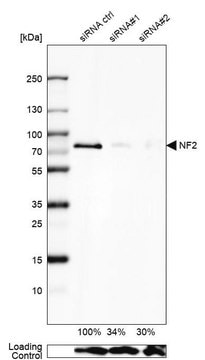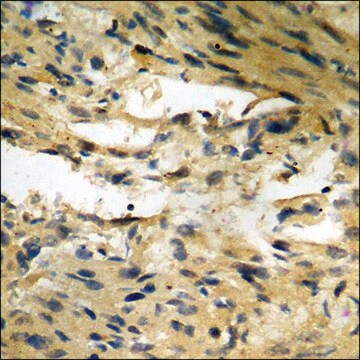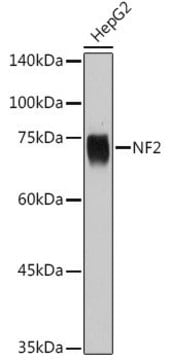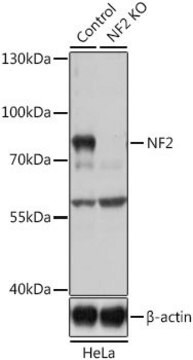MABN1786
Anti-Merlin (NF2) Antibody, clone 1C4
clone 1C4, from mouse
Synonym(s):
Merlin, Moesin-ezrin-radixin-like protein, Neurofibromin-2, Schwannomerlin, Schwannomin
About This Item
Recommended Products
biological source
mouse
Quality Level
antibody form
purified antibody
antibody product type
primary antibodies
clone
1C4, monoclonal
species reactivity
rat, mouse, human
technique(s)
immunocytochemistry: suitable
immunoprecipitation (IP): suitable
western blot: suitable
isotype
IgG1κ
NCBI accession no.
UniProt accession no.
shipped in
ambient
target post-translational modification
unmodified
Gene Information
human ... NF2(4771)
General description
Specificity
Immunogen
Application
Immunocytochemistry Analysis: A representative lot detected merlin cellular distribution and HEI10 co-localization in a cell cycle-dependent manner by fluorescent immunocytochemistry staining of 3.5% paraformaldehyde-fixed U2OS human osteosarcoma cells (Grönholm, M., et al. (2006). Oncogene. 25(32):4389-4398).
Immunocytochemistry Analysis: A representative lot detected merlin cellular localization by fluorescent immunocytochemistry staining of 3.5% paraformaldehyde-fixed embryonic E16 rat neurons. Merlin was seen co-localized with RI to the cell body and extensions in a punctate pattern (Grönholm, M., et al. (2003). J. Biol. Chem. 278(42):41167-41172).
Immunocytochemistry Analysis: A representative lot detected merlin cellular localization by fluorescent immunocytochemistry staining of 4% paraformaldehyde-fixed, 0.1 NP-40-permeabilized human fibroblasts and primary meningioma cells. Merlin co-localized with F-actin at the leading and ruffling edges, but not at the stress fiber. No merlin co-localization with ezrin or moesin was observed (Gonzalez-Agosti, C., et al. (1996). Oncogene. 13(6):1239-1247).
Immunoprecipitation Analysis: A representative lot co-immunoprecipitated N-WASP with merlin from HEK293T cell lysate (Manchanda, N., et al. (2005). J. Biol. Chem. 280(13):12517-12522).
Western Blotting Analysis: A representative lot detected the presence of wild-type, but not L64P, merlin in the EGFR immunoprecipitates from Nf2-/- MEFs infected by adenovirus to express either wild-type or L64P merlin (Curto, M., et al. (2007). J. Cell Biol. 177(5):893-903).
Western Blotting Analysis: A representative lot detected a reduced merlin level in EGFR immunoprecipitate from mouse liver-derived epithelial cells (LDCs) upon shRNA-mediated NHE-RF1, but not NHE-RF2 knockdown. Merlin association with Ezrin was not affected by NHE-RF1 knockdown (Curto, M., et al. (2007). J. Cell Biol. 177(5):893-903).
Western Blotting Analysis: A representative lot detected a ~72 kDa merlin band in rat newborn fibroblast (RNF) and S-16 rat Schwann cell lysates, as well as a ~66 kDa merlin band in murine NIH/3T3 and human MRC-5 fetal fibroblast lystes without cross-reactivity toward the three ERM protein family members, ezrin, radixin, and moesin (Gonzalez-Agosti, C., et al. (1996). Oncogene. 13(6):1239-1247).
Neuroscience
Quality
Western Blotting Analysis: 4 µg/mL of this antibody detected Merlin (NF2) in 10 µg of HEK293 cell lysate.
Target description
Physical form
Storage and Stability
Other Notes
Disclaimer
Not finding the right product?
Try our Product Selector Tool.
Storage Class Code
12 - Non Combustible Liquids
WGK
WGK 1
Flash Point(F)
Not applicable
Flash Point(C)
Not applicable
Certificates of Analysis (COA)
Search for Certificates of Analysis (COA) by entering the products Lot/Batch Number. Lot and Batch Numbers can be found on a product’s label following the words ‘Lot’ or ‘Batch’.
Already Own This Product?
Find documentation for the products that you have recently purchased in the Document Library.
Our team of scientists has experience in all areas of research including Life Science, Material Science, Chemical Synthesis, Chromatography, Analytical and many others.
Contact Technical Service








